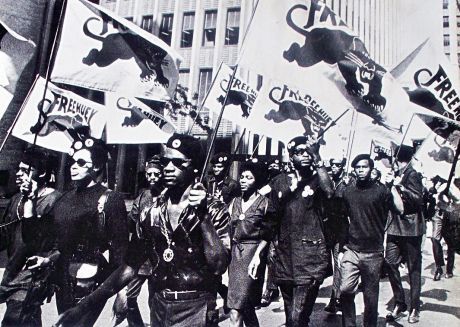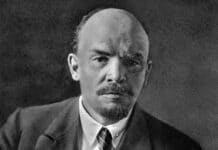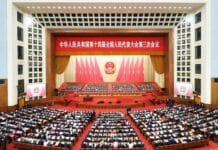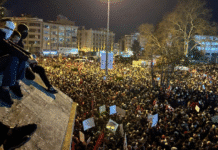October 15th is the anniversary of the founding of the Black Panther Party in 1966. We reprint here an article written before the murder of George Floyd, but whose lessons remain even more valid today.
Teddy Shibabaw, Socialist Alternative (ISA in United States)
ust two years since the historic protests in Ferguson, Missouri, the Black Lives Matter movement has already made a deep and broad impact on U.S. politics. No aspect of culture has gone untouched, and in 2016 celebrities like Beyoncé and Colin Kaepernick further brought the issue of racism into mainstream media and society. While the movement has already succeeded in greatly advancing the discussion about race in America, it is still searching for the means to make fundamental and lasting change.
The questions facing the movement today evoke the history of the last major period of the black freedom struggle, the Civil Rights and Black Power movements, whose highest expression was the development of the Black Panther Party for Self Defense. Bold and militant, the Panthers at once scared the hell out of the racist establishment and inspired the Black working class, poor and youth. Though they carried out work on multiple fronts, they are best known for their armed patrols in black communities. In the context of ongoing and brutal police violence, the patrols were experienced as a daring defense of black life and dignity.
The Black Panthers were founded in Oakland, California 50 years ago this last October. The party was born at a critical juncture between the ebbing of the Southern-Based Civil Rights movement and beginning of the Black Power era, as the experiences of the struggle fueled a debate about more far reaching questions. The movement led by Martin Luther King, Jr and the Southern Christian Leadership Conference, had legally smashed Jim Crow segregation in public facilities, and succeeded in passing the Voting Rights Act and the Civil Rights Act. Yet the basic conditions of existence for the overwhelming mass of Black people remained largely unchanged, defined by segregated housing, discrimination in access to higher education and decent jobs and higher rates of poverty. This led MLK to ask: “What good is having the right to sit at a lunch counter if you can’t afford to buy a hamburger?”
Both Martin Luther King Jr and Malcolm X spoke to the limits of the movement’s formal and legal gains, but they were cut down by assassins’ bullets as they raised questions about capitalism and more fundamental change.
It was the Black Panthers that took the matter head on in the years that followed. The Panthers’ attitude was clearly expressed by Bobby Seale when he said, “We do not fight racism with racism. We fight racism with solidarity. We do not fight exploitative capitalism with Black capitalism. We fight capitalism with basic socialism. And we do not fight imperialism with more imperialism. We fight imperialism with proletarian internationalism.” The Panther’s approach made a clean break with both “cultural nationalists” and the liberal, pacifist integrationists.
Co-founders Bobby Seale and Huey P. Newton set about writing the Panthers’ famous 10-point program in the backroom of a community center, which included demands calling for radical democratic reform and economic justice.
The Black Panther Party’s ten point programme (short version)
- We want freedom. We want power to determine the destiny of our Black and oppressed communities.
- We want full employment for our people.
- We want an end to the robbery by the capitalist of our Black and oppressed communities.
- We want decent housing, fit for the shelter of human beings.
- We want education for our people that exposes the true nature of this decadent American society. We want education that teaches us our true history and our role in the present-day society.
- We want completely free health care for all Black and oppressed people.
- We want an immediate end to police brutality and murder of Black people, other people of color, all oppressed people inside the United States.
- We want an immediate end to all wars of aggression.
- We want freedom for all Black and poor oppressed people now held in U.S. federal, state, county, city and military prisons and jails. We want trials by a jury of peers for all persons charged with so-called crimes under the laws of this country.
- We want land, bread, housing, education, clothing, justice, peace and people’s community control of modern technology.
The Panthers grew quickly in the Bay Area. But it was a daring action at the California State Legislature in Sacramento, in which they entered the building armed with rifles and read aloud a statement in opposition to the Mulford Bill (aimed at eliminating their armed community patrols), that gave them a national spotlight and led to their explosive growth throughout the nation. In addition to opposing police brutality, the Panthers organized rent strikes, and free breakfast, medical care and clothing programs that were combined with revolutionary education and recruitment. At their height, the Panthers had a circulation of 250,000 for their newspaper and 5,000 full-time party members.
But as quickly as they had risen, their decline began all too soon.
FBI Director J. Edgar Hoover, famously called the Panthers “the greatest threat to internal security of the country.” While the Panthers’ armed patrols certainly got the attention of Hoover and others, what unnerved the establishment far more was the Panthers’ socialist politics and potential to detonate a mass revolutionary movement of black workers and youth. These fears were greatly intensified as the Panthers began building broader alliances with organizations representing Latinos, Native Americans and poor whites, leading in the direction of a united struggle of oppressed people. The FBI’s COINTELPRO program of jailings, infiltration, misdirection, and assassinations was a major blow to the Panthers. The FBI brutally killed 25 Panthers in one year, in 1969, and went on to unjustly imprison several hundred more.
While ruling class repression could be expected, it was not inevitable that it would be successful, and other revolutionary movements across the world have withstood far more severe attacks. The Black Panthers’ mistakes in revolutionary strategy unfortunately contributed to their decline.
The Panthers had overwhelmingly focused on the most oppressed sections of the black population who were either permanently unemployed or underemployed, while setting up obstacles to the membership and participation of millions of black workers (including requiring every member to become a full-timer). This dramatically limited their size and social weight. Every revolutionary movement should organize the unemployed, but it must also base itself on the working class, the most progressive force in society with the social power to bring the economy to a halt. Had they built a mass membership with democratic structures, instead of taking their cues from the Chinese and Cuban revolutions, they could have built a force of tens of thousands that could have shielded them from crushing repression.
Finally, their use of guns had another side to it. For many black workers and poor, it made the organization into a group of heroic leaders they could revere and celebrate, but not one they could join. Huey Newton himself came to realize this, and later wrote: “But we soon discovered that weapons and uniforms set us apart from the community. We were looked upon as an ad hoc military group, acting outside the community fabric and too radical to be a part of it. Perhaps some of our tactics at the time were extreme.”
Despite mistakes and missed opportunities, the Black Panthers wrote a vital and heroic chapter in U.S. history, and contributed greatly to the advance of democratic freedoms. Our generation has enormous lessons to learn from their successes and failures alike, and we stand on their shoulders today as we continue the fight for black freedom and socialism.




